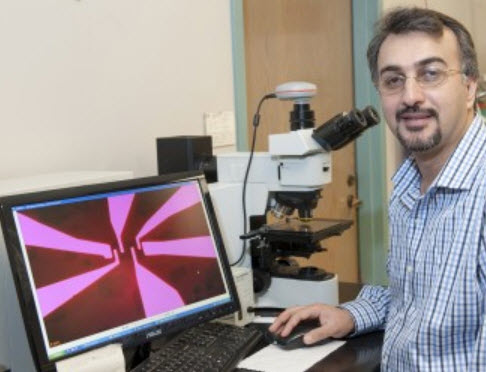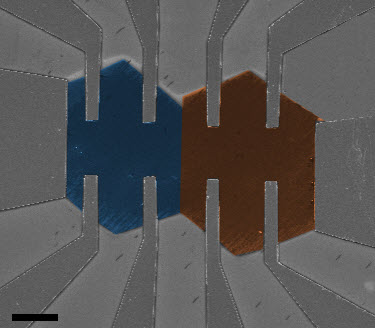Graphene flaws could be used to create hypersensitive ‘electronic nose’
October 2, 2014

Amin Salehi-Khojin, UIC assistant professor of mechanical engineering, with image of graphene grain boundary (credit: Roberta Dupuis-Devlin/UIC Photo Services)
University of Illinois at Chicago (UIC) researchers have discovered a way to create a chemical sensor that could increase sensitivity to absorbed gas molecules by 300 times, based on imperfections in graphene sheets.

A false-color scanning electron microscopy image of the chemical sensing device fabricated on an individual graphene grain boundary. The blue and orange colors represent two hexagonal single crystalline grains that are coalesced, forming the grain boundary. The gold electrodes (light gray) are patterned to measure the electric resistance of the grains as well as the grain boundary during the sensing experiments. Scale bar: 5 micrometers. (Credit: Poya Yasaei and Amin Salehi-Khojin)
The researchers discovered that gas molecules accumulate at micrometer-sized, individual graphene grain boundaries, making them ideal spots for sensing gas molecules.
The irregular nature of the grain boundary produces hundreds of electron-transport gaps with different sensitivities.
The idea is to create sensor arrays from multiple grain boundaries.
It should be possible to “tune” the electronic properties of these arrays using controlled chemical doping to create an “electronic nose” sensitive enough to detect even a single gas molecule, said Amin Salehi-Khojin, UIC assistant professor of mechanical and industrial engineering.
The study, published in Nature Communications, was supported by the National Science Foundation, the Department of Energy, National Science Foundation, and the U.S. Defense Threat Reduction Agency.
UPDATE Oct. 3, 2014: microscopy image added, provided exclusively to KurzweilAI.
Abstract of Chemical sensing with switchable transport channels in graphene grain boundaries
Grain boundaries can markedly affect the electronic, thermal, mechanical and optical properties of a polycrystalline graphene. While in many applications the presence of grain boundaries in graphene is undesired, here we show that they have an ideal structure for the detection of chemical analytes. We observe that an isolated graphene grain boundary has ~300 times higher sensitivity to the adsorbed gas molecules than a single-crystalline graphene grain. Our electronic structure and transport modelling reveal that the ultra-sensitivity in grain boundaries is caused by a synergetic combination of gas molecules accumulation at the grain boundary, together with the existence of a sharp onset energy in the transmission spectrum of its conduction channels. The discovered sensing platform opens up new pathways for the design of nanometre-scale highly sensitive chemical detectors.